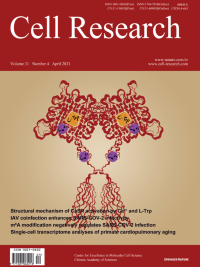
Advanced Search
Submit Manuscript
Advanced Search
Submit Manuscript
Volume 31, No 4, Apr 2021
ISSN: 1001-0602
EISSN: 1748-7838 2018
impact factor 17.848*
(Clarivate Analytics, 2019)
Volume 31 Issue 4, April 2021: 395-403 |
Coinfection with influenza A virus enhances SARS-CoV-2 infectivity
Lei Bai1 , Yongliang Zhao1 , Jiazhen Dong , Simeng Liang1 , Ming Guo1 , Xinjin Liu1 , Xin Wang1 , Zhixiang Huang1 , Xiaoyi Sun1 , Zhen Zhang1 , Lianghui Dong1 , Qianyun Liu1 , Yucheng Zheng1 , Danping Niu1 , Min Xiang1 , Kun Song1 , Jiajie Ye1 , Wenchao Zheng1 , Zhidong Tang1 , Mingliang Tang1 , Yu Zhou1 , Chao Shen1 , Ming Dai2 , Li Zhou1,2 , Yu Chen1 , Huan Yan1 , Ke Lan1,2,3,* , Ke Xu1,*
1State Key Laboratory of Virology, College of Life Sciences, Wuhan University, Wuhan, Hubei 430072, ChinaThe upcoming flu season in the Northern Hemisphere merging with the current COVID-19 pandemic raises a potentially severe threat to public health. Through experimental coinfection with influenza A virus (IAV) and either pseudotyped or live SARS-CoV-2 virus, we found that IAV preinfection significantly promoted the infectivity of SARS-CoV-2 in a broad range of cell types. Remarkably, in vivo, increased SARS-CoV-2 viral load and more severe lung damage were observed in mice coinfected with IAV. Moreover, such enhancement of SARS-CoV-2 infectivity was not observed with several other respiratory viruses, likely due to a unique feature of IAV to elevate ACE2 expression. This study illustrates that IAV has a unique ability to aggravate SARS-CoV-2 infection, and thus, prevention of IAV infection is of great significance during the COVID-19 pandemic.
https://doi.org/10.1038/s41422-021-00473-1